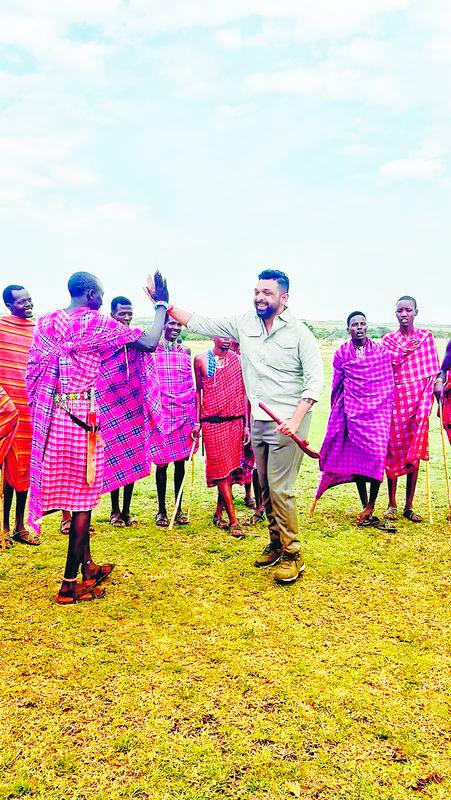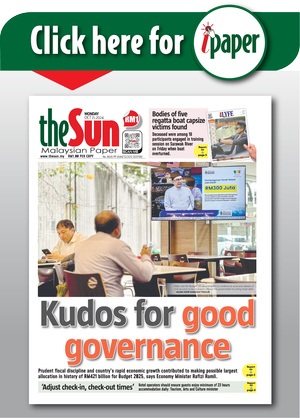The Maasai show that a true binding narrative is rooted in daily life, in the repeated telling of what matters, not just spectacle. – PIC COURTESY OF DINESH NAIR
LAST week, I journeyed to Africa. While its famous animals are a spectacle in their own right, I was equally interested – thanks to my anthropological background – in meeting the Maasai people.
The Maasai are a semi-nomadic pastoralist people primarily inhabiting southern Kenya and northern Tanzania. Cattle lie at the heart of Maasai life, symbolising wealth, social status and spiritual power. Their entire livelihood, from diet to social relationships, revolves around the well-being of their herds.
Standing among the sunbaked, circular huts of a Maasai cultural manyatta (loosely described as a “village”) near the edge of Kenya’s great wildlife reserves, I was first swept away by the drama of it all – red-shuka-clad warriors singing, women in intricate beadwork swaying rhythmically, children peeking shyly from behind thorn-fenced corrals. This was what tourists came for – a vision of the Maasai wrapped in mythic charm.
A few days later, as I continued to interact with David, the village chief, with whom I had formed a somewhat genuine bond, he began to hint that what I had witnessed was not a faithful representation of a “real” manyatta found in the more remote areas of the land.
A cultural manyatta, like the one I visited, is essentially a Maasai homestead found within or around national parks to cater to international tourists. These manyattas are nevertheless genuine, they are not merely imitations of the original. They are authentic in that they are traditional settlements built by Maasai people who continue to live in accordance with their long-held tribal customs.
These insights did not come all at once, some emerged only after I had left the country, through continued conversations over the phone. I later sought to verify David’s account with a fellow British anthropologist who had visited both types of homesteads, and he concurred.
According to him, the structure of the cultural manyatta closely resembles the former – same materials, similar layout of homes and thorn fences. The Maasai dress identically in both.
Differences exist too. While singing and dancing exist in traditional homesteads, they are not staged for tourists. There, the daily life of tending livestock, negotiating marriages or simply arguing over grazing routes have a completely different rhythm to Maasai existence – it was messy and dynamic, far from the frozen ideal the cultural manyatta presents.
In a “real” manyatta, one is a friend and guest while in the cultural version, a client and spectator. The major difference is authenticity.
The cultural manyatta reflects the toll of modernisation, revealing to tourists a Maasai culture in transition towards Western values, in which the quest and requirement for money have become increasingly central. Beadworks would be carefully laid out to target what tourists were most likely to buy.
The Maasai, particularly those living in close proximity to the national reserves, are not to blame for this reality.
Despite wildlife parks generating significant tourism revenue, the Maasai themselves see little benefit. They continue to coexist with the animals that attract countless visitors, yet receive no compensation for the damage these animals inflict or for the restrictions imposed on their traditional lifestyles by conservation laws.
Cultural manyattas indirectly support wildlife conservation, since parks and reserves – established on former Maasai land – enforce strict punishments against harming wildlife, making it impossible for the Maasai to defend their livelihoods from destructive animals. This leaves them at a disadvantage, unable to gain from conservation and tourism unless they find ways to participate economically.
These cultural manyattas have become one such path, enabling them to share in tourism profits while contributing to the conservation movement.
Still, despite these justifications, many observers would remain critical of what is happening. The cultural manyatta is, after all, an example of the commoditisation of Maasai culture. It is a place where Maasai identity is reworked, repackaged and reproduced specifically for the entertainment of a tourist audience.
Although originally idealised as a way to preserve Kenya’s national cultural heritage, the cultural manyatta in practice has evolved into a marketing enterprise that is centred on indigenous realism.
The authenticity of staged culture
It was a powerful experience that forced me to confront some uncomfortable truths, not only about how we as visitors consume culture abroad but also how we present our own Malaysian multicultural identity at home.
The Maasai cultural manyattas left me thinking about Edward Bruner’s striking phrase: “In tourism, authenticity is made, not discovered.”
This statement resonates far beyond Kenya’s savannahs. It echoes in Malaysia’s glossy multicultural tourism branding, in which we often take pride in being “Truly Asia”, showcasing silat demonstrations, lion dances, silambam displays, Gamelan ensembles, Kadazan harvest rituals and other carefully curated sets of ethnic displays to the world.
All of these are beautiful, valuable and rooted in real communities but bundled in neat ways for tourism events. Like the Maasai manyattas, these images preserve elements of tradition while simultaneously commodifying them.
Yet, even as we criticise these staged performances, it is worth asking whether the sense of belonging and pride behind them is truly inauthentic.
The Maasai example reveals a striking paradox, even a commoditised cultural performance can retain authentic inner meaning. Whereas in Malaysia, even the most vivid multicultural spectacles struggle to cultivate a similar shared sense of belonging and identity.
Role of myths
This is perhaps explained by the fact that the Maasai remain bound together by something far more powerful – storytelling.
For instance, the village chief spoke glowingly about the lion hunts of his grandfather. These tales may seem stretched today, especially since actual lion hunting is now rare. Whether the details are exaggerated or literally true is beside the point – the stories work. They weave a powerful narrative of what it means to be Maasai – a collective identity built on consistent myths that cultivate solidarity and a common purpose.
Contrast that with Malaysia, where “multiculturalism” is a phrase constantly repeated but rarely lived in daily reality. We pride ourselves on diverse festivals but those are no match for the hard conversations about inequality, suspicion and discrimination that fracture our society.
Yes, we have our Malaysia Boleh! slogan, which temporarily unifies us in moments of badminton or football frenzy but these cycles of sporting glory fade and the old fault lines re-emerge.
The Maasai show that a true binding narrative is rooted in daily life, in the repeated telling of what matters, not just spectacle. Although some of these myths may be performed in the manyatta for tourists, they are also lived outside it, as Maasai elders and warriors pass on legends that define who they are, who they want to be and how they expect their children to behave.
What we lack is a sustaining national narrative, a collective mythos that binds Malaysians across generations, ethnicity and class, giving us something to rally around that is more durable than the Merdeka chants which echo only in the weeks leading up to the end of August each year.
The Maasai, on the other hand, even in the face of profound hardship – land loss, wildlife conflicts and the commodification of their identity – keep telling their stories.
This is not to suggest we should brazenly manufacture myths to project a comforting narrative. The Maasai acknowledge the exaggerations within their stories, yet these do not diminish the core values they intend to transmit. Their stories express how they aspire to see themselves – an imagined ideal of courage, service and unity. That is something Malaysians could learn to envision, project and uphold more boldly, without denying our flaws.
Malaysia’s multiculturalism may seem authentic to tourists – just as the Maasai manyatta experience. But to its own citizens, it can feel hollow. Our schools still struggle with ethnic integration. Our workplaces still mirror old divisions. Our neighbourhoods are still suspicious of “the other”.
A cohesive national narrative cannot be built on a slogan alone, it needs shared myths that belong to everyone, repeated from childhood, taught in classrooms, told around dinner tables, argued over in coffee shops and adapted over time.
The question is what that unifying myth or narrative may look like for us. Many point to sports but that seems insufficient, or at best complementary. It brings us together now and then but only for a while. Could there be something deeper, a narrative we can build together that outlasts a match or a medal?
Perhaps, the clue lies in our classrooms. If any place should nurture the seeds of a shared story, it is our schools. Our teachers stand at the frontline of shaping how the next generation sees Malaysia – whether as a tidy tourism poster of cultural costumes or as a living, evolving nation that learns, struggles and grows together.
Education is where stories are passed down, retold and reimagined. If we can find a way to encourage a hopeful national narrative in schools – one that includes everyone and leaves no community as a silent bystander – then we may have something more powerful than any staged festival or yearly sports chant.
In the end, the Maasai show that even mythologised performances can be productive if they are sustained with clear intent and rooted in shared values. That is how unity, even in diversity, can become real.
The challenge for us is to ask: “What stories, myths and ideals will we teach and retell, and what might we still dare to create?”
Important qualification
I recognise that Malaysia’s challenges emerge within a multiethnic national context, unlike the Maasai, who form a single ethnic community. This is neither an attempt to simplify the complex realities of navigating multiculturalism, nor a suggestion that a cultural template from East Africa can be neatly superimposed onto our own social fabric.
I also recognise that, viewed through a Western lens, there are power dynamics within Maasai society itself – particularly around gender roles, the position of wives in traditional homesteads and the role of children within rigid age-based structures and informal educational systems – that deserve scrutiny.
My intention is not to overlook those internal contradictions but to focus on a specific dimension – how myths and collective narratives can serve as generative tools for cohesion, aspiration and cultural continuity. Within that confined scope, the Maasai example still offers something Malaysians may reflect on meaningfully.
Dinesh Nair is a social anthropologist and a recipient of the UK Government’s Chevening Scholarship. He holds a Master of Arts in Social Anthropology (Distinction) from the University of Manchester and a Master of Science in Marketing and Business Analysis from the University of Edinburgh. An advocate of interdisciplinary studies, he has held academic, non-academic and consultancy positions at a few private universities in Malaysia and India. Comments: letters@thesundaily.com
PS: This article is the first instalment of a two-part series, “Anthropologically Speaking: The Kenyan Chronicles”. Part two will appear next Saturday.









